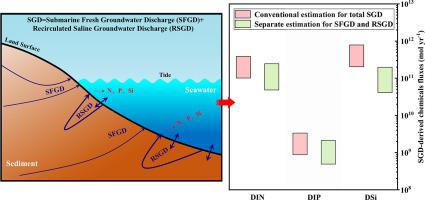Geoscience Frontiers ( IF 8.9 ) Pub Date : 2021-05-15 , DOI: 10.1016/j.gsf.2021.101204 Jianan Liu , Jinzhou Du , Xueqing Yu

|
Submarine groundwater discharge (SGD) is being increasingly recognized as a significant source of nutrient into coastal waters, and generally comprises two components: submarine fresh groundwater discharge (SFGD) and recirculated saline groundwater discharge (RSGD). The separate evaluation of SFGD and RSGD is extremely limited as compared to the conventional estimation of total SGD and associated nutrient fluxes, especially in marginal-scale regions. In this study, new high-resolution radium isotopes data in seawater and coastal groundwater enabled an estimation of SGD flux in a typical marginal sea of the Yellow Sea. By establishing 226Ra and 228Ra mass balance models, we obtained the SGD-derived radium fluxes, and then estimated the SFGD and RSGD fluxes through a two end-member model. The results showed that the total SGD flux into the Yellow Sea was equivalent to approximately 6.6 times the total freshwater discharge of surrounding rivers, and the SFGD flux accounted for only 5.2%–8.8% of the total SGD. Considering the nutrient concentrations in coastal fresh and saline groundwater, we obtained the dissolved inorganic nutrient fluxes (mmol m−2 yr−1) to be 52–353 for nitrogen (DIN), 0.21–1.4 for phosphorus (DIP), 34–226 for silicon (DSi) via SFGD, and 69–262 for DIN, 1.0–3.9 for DIP, 70–368 for DSi via RSGD, with the sum of nutrient fluxes equaling to (1.8–9.3)-fold, (1.3–5.6)-fold and (2.0–9.5)-fold of the riverine inputs. Compared to the conventional estimation of the total SGD flux, the nutrient fluxes derived from the separation of SFGD and RSGD were (1.6–2.1), (1.6–1.8) and (4.0–4.9) times lower for DIN, DIP and DSi, respectively, indicating that the estimates by separating SFGD and RSGD could be conservative and representative results of the Yellow Sea. Furthermore, we suggested that SGD played an important role in nutrient sources among all the traditional nutrient inputs sources, providing 15%–48%, 33%–68% and 14%–43% of the total DIN, DIP and DSi input fluxes into the Yellow Sea, and the high nutrient stoichiometric ratios (i.e., DIN/DIP) in SGD probably contributed to the increasing ratios in the Yellow Sea. In addition delivering large amounts of nutrient into the Yellow Sea, SGD would create primary productivity of 10–49, 1.6–6.8 and 8.8–42 g C m−2 yr−1 based on N, P and Si, which were equivalent to 5.2%–27%, 0.9%–3.7% and 4.7%–23% of the total primary productivity, respectively. In particular, the SFGD-derived DIN flux can be converted to primary productivity of 4.2–28 g C m−2 yr−1 thus demonstrating the disproportionately large role of SFGD in ecological environment of the Yellow Sea relative to its flux. Therefore, we conclude that SGD, particularly SFGD, plays an important role as a nutrient source for the Yellow Sea, and not only affects nutrient budgets and structures but also enhances the primary productivity.



























 京公网安备 11010802027423号
京公网安备 11010802027423号